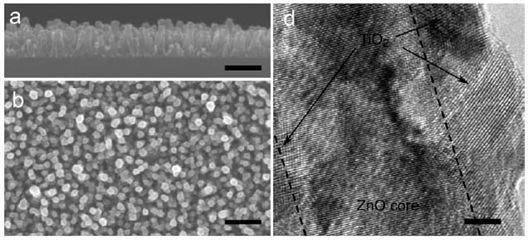博文
基于ZnO一维纳米结构的太阳能电池
||
最近看到Peidong Yang 的一篇solar cell 的文章,以letter的形式发表在JPCC上面(ZnO-TiO2 Core-Shell Nanorod/P3HT Solar Cells,刚出来的文章,没有编页码). 文章讲的材料是TiO2包袱的ZnO纳米棒阵列。当然文章不是什么大的突破,但是作为基础研究,提高电池的性能方面的确有价值. 只要想想他们2005年的一篇Nature Materials的文章(Nanowire dye-sensitized solar cells,Nature Materials 4, 455 - 459 (2005) doi:10.1038/nmat1387),就看得出他们一直在这方面努力工作着,呵呵。
Yang在氧化锌方面的成就,我个人观点,应该不亚于Zhonglin Wang. 一个液相合成,一个是气相制备;一个在2001年报道世界上第一个基于ZnO纳米线的激光器,一个在2006-2007年报道氧化锌的纳米发电机;的确各有千秋。Yang在05年的这篇nature materials,开拓了一维ZnO纳米结构在太阳能电池上的研究,暗示着这种明星材料的perfect vertical array(而不是纳米颗粒薄膜)具有很大的应用潜力。在最近的JPCC文章里面,有这样一段话:Several theoretical studies conclude that the ideal polymer-inorganic device topology is a perfect vertical array of single-crystalline nanorods of the appropriate dimensions and pitch, encased in a film of the polymer.The nanorods should complement the polymer as a light absorber in addition to serving as the electron acceptor. In principle, the nanorod design is optimal because it (i) provides direct channels for electron and hole transport to the electrodes, (ii) features a higher electron mobility in the inorganic phase, and (iii) provides a scaffold on which the polymer can be annealed to optimize its hole mobility without the risk of phase separation.
当然,氧化锌的合成早已成为历史,怎样实现其的实际应用才是现在研究者极力追求的。我对氧化锌的纳米阵列也很感兴趣,最近还在尝试着将他们应用到其他的装置中去。说起来,有序排列的阵列结构的确在很多方面比随机的杂乱的纳米结构薄膜,或者纳米颗粒薄膜好的多。加上ZnO 的优异的光电性能,如果有效的加以修饰,掺杂,改性,相信一定会有更多潜在的应用。

Figure:(from the new JPCC)Structural characterization of the ZnO-TiO2 core-shell nanorod arrays used in this study. (a) Cross-sectional and (b) plan-view SEM images of a ZnO nanorod array on silicon coated with 6 nm of TiO2 by ALD. Scale bars, 200 nm. (c) TiO2 shell thickness against number of ALD cycles. Error bars represent one standard deviation of 30 data points. The dashed line is a least-squares fit, intercept set at origin. (d) Highresolution TEM image of a ZnO-TiO2 nanorod, showing a single-crystalline ZnO core coated with polycrystalline anatase TiO2 (as determined by XRD (not shown)). Scale bar, 5 nm. The ZnO core is outlined with dashed lines. (e) Corresponding energy dispersive spectroscopy (EDS) elemental linescan across the nanorod.
https://blog.sciencenet.cn/blog-4293-11799.html
上一篇:RSC Publishing-New Journal Announced
下一篇:忙碌的年末